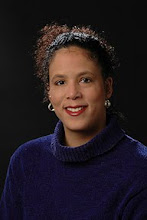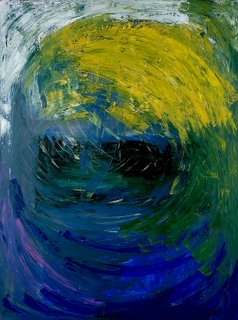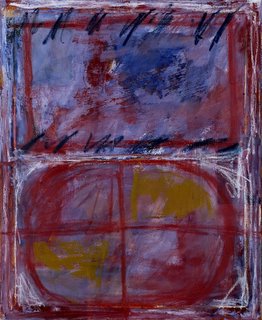by:
Lynne Taetzsch When I paint, I am not attempting to capture the likeness of a landscape or figure. My subject is the painting itself. In spite of this, some viewers immediately try to pin down an image they can name in my art. Not that seeing things in abstract paintings is a crime, even if the artist didn't put them there. But you miss an opportunity to see more if you spend all your energy trying to turn the painting into something you can name, like a figure or flower or landscape.
What do you actually see when you look at the painting? Color, shape, line and texture are the physical elements that combine to make up the image. A selection of dark, heavy shapes may impress you as somber; light, airy images as mystical; balanced, and temperate forms as peaceful. Shape, color and form have meaning in and of themselves. We react emotionally to these elements even if they create no recognizable object for us to hang onto. Thus, a painting of ragged, angular forms in deep reds will evoke an entirely different feeling from one in soft curves of yellow and white.
The handling of space, or the illusion of space, is another element in the artist's toolbox. Are you drawn into a world of three-dimensional space stretching beyond the framework of the painting, as you might be in a landscape? Or are you kept visually taut, as a skater on a pond, skimming across a two-dimensional surface? The impression of depth, perspective, airiness, solidity, and other spatial relations are created and controlled by the artist.
The overall composition or design of a painting is what guides the viewer's eye. Have you ever looked at a painting or photograph and felt it was off balance? One of the big differences between amateur snapshots and professional photographs is the quality of the composition. In an amateur photo, perhaps all the action is centered on the left, with nothing but empty space on the right. The lopsidedness gives you a sense of unease. (Of course an artist may use this unease deliberately as well.)
Composition is one of the fundamental tools an art student is taught. The goal is to have a balance of visual elements without making the weight so balanced that the art becomes boring. If everything on the left is exactly equal to the right, and the top to the bottom, you may have balance, but you lose interest.
Getting the composition right, or balancing the elements of color, line and shape while maintaining a dynamic tension, is a major preoccupation of the painter. If you add a blue brushstroke to the bottom left-hand corner, for example, you may have to change something in the top right-hand corner because of it. You can't concentrate on one section at a time, ignoring the rest of the canvas, and expect to end up with a composition that works.
Energy is the life force that is present in all good art. This is not something that is easily defined, but it is the opposite state of static flatness. It is this energy that makes a painting speak to you, and makes an artist's work original and identifiable as the work of that artist. Energy is created out of the artist's materials and tools, but the end is more than the means in the same sense that a musical composition is so much more than a collection of notes.
The next time you look at an abstract or “modern” painting, don't begin by searching for some identifiable object from your world. Instead, try to enter the world the artist created. Relax and let your eye leisurely wander over the painting's surface. Let your heart and mind react to its colors, shapes, and textures. Let yourself be drawn into the illusion of its spaces, the action of its lines, and the mood of its atmosphere.
Step back and look at the painting from a distance. What is its impact as you approach it?
Move up close and explore the intricacies of brushstrokes, paint thicknesses and compositional details. See how the parts are woven together to form the whole.
Give the painting time. No artwork can be understood and appreciated in a ten second glance. Good art should grow on you, becoming more interesting and more enjoyable to look at as you live with it.
You may still see things in abstract paintings, finding birds and trees and animals hidden in the forms. This is as natural as turning clouds into recognizable shapes. But by opening your eyes to the possibilities of the world the artist created, you may see more than you ever expected to see in abstract art.
Copyright 2006 Lynne Taetzsch
About The Author
Lynne Taetzsch is an artist and writer who has published books with Van Nostrand Reinhold, Regnery & Co., Watson-Guptill, and Faber & Faber publishers. Her contemporary abstract paintings have been shown in solo and group exhibitions throughout the world, and she currently has a studio in Ithaca, New York. Visit her online art gallery at http://www.artbylt.com



